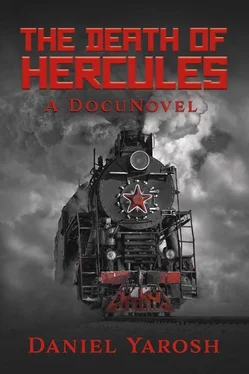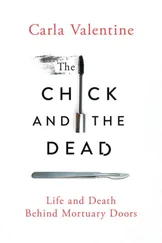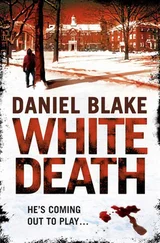The unquenchable fury of the Revolution now focused like a laser upon the last common enemy. On a mid-July day, the order went out from Moscow to Ekaterinburg, where nearby the former Tsar Nicholas II and his family were held under arrest in a modest townhouse by the Bolshevik Regional Soviet of the Urals. The stone building, which was a former merchant’s house, now had all the windows whitewashed on both sides and a rough fence hammered together on the perimeter. The soldiers had decorated the single toilet with obscene drawing of the Tsarina in various couplings with Rasputin. The counter-revolutionary Czech Legion and the White Russian Army had taken several towns nearby. The Bolshevik defense had collapsed and retreated behind Ekaterinburg. Late on July 16, Soviet Commander Iakov Iurovsky, a Jew converted to Lutheranism and a dedicated Bolshevik, received instructions from Yakov Sverdlov, chairman of the All-Russian Central Executive Committee. Iurovsky in turn ordered Pavel Medvedev, the Cheka chief guard on duty, to immediately bring all the Nagant revolvers, and whatever other pistols were hidden away in the barracks, to his office. He thought the pistols might make less noise than rifles and not alarm the locals. In the middle of the night, the now well-armed guards herded the Royal Romanov family into the basement of the wooden Dachau, and Iurovsky personally fired the first bullet into the forehead of Nicholas. He then turned on his young son, the hemophiliac heir Alexander, and the guards finished off the Tsarina and her daughters, Anastasia included. They collected the bodies and took them five miles outside of Ekaterinburg to the Four Brothers mine, where they burned them with gasoline and dumped fifty gallons of sulfuric acid onto the remains. Back at the Dachau, soldiers scrubbed down the basement in a futile attempt to hide the regicide from history.
The news could not be kept quiet. Although the Tsar and his family were despised at the time of the Revolution, the wholesale murder of a family was met with revulsion both inside Russia and abroad. In a spineless act of political expediency, the Bolshevik central committee ordered the arrest of Iurovsky and Medvedev and their extradition to Moscow, where they were executed for disobeying the Central Soviet Committee. Nevertheless, the elimination of the Tsar and his family showed the Russian people and the world that there was no turning back.
What was ahead was fear. On August 30, Moisei Uritsky, the head of the Petrograd Cheka was assassinated by Leonid Kannegisser, a military cadet. Uritsky’s well-known aversion for the terror of the Bolsheviks was no protection. His death was a signal that the resistance inside Russia had access to the highest leaders, including the head of security in the second largest city. Lenin immediately dispatched General Dzerzhinsky to Petrograd to torture the assassin into disclosing if he was part of a larger plot against the Bolsheviks. Upon Dzerzhinsky’s arrival at the Petrograd train station, a small contingent of loyal Cheka met him with more news. In Moscow, Lenin had been shot.
A few days after the convention hall was retaken from the LSR, Lenin spoke at a rally at the Mikhelson factory to mobilize workers to save the Revolution with more hours and less food and little pay. Fanya Kaplan, a dedicated Anarchist, waited by the podium with a Browning pistol tucked in her straw bag. She was meek and mousy and nearly completely blind. She had already been imprisoned by the Tsar as a bomb thrower, and in prison she had been stripped and beaten with a cane, which cost her much of her eyesight. Now, because of the peace with Germany, she considered Lenin a traitor to the revolution. As Lenin made his way to his car, she pulled out her gun and managed to fire three shots. The first missed, the second wounded Lenin in the arm, but the third bullet passed through his neck and lodged near his spine. Bleeding profusely, he was hurried into a car driven by his chauffer Stepan Gil. Rather than go to a hospital, where further assassins may lay in wait, Lenin was driven to the Kremlin. Maria Ilinicha, his sister, sent a messenger to a pharmacist for medicine but doctors were not summoned for a day. Lenin barely survived the week. The third bullet remained lodged in his neck until it was removed in 1922, whereupon he suffered a massive stroke.
Kaplan was easily apprehended but she refused to disclose her confederates. On Sept 3, 1918 she was shot, and her body incinerated on the order of Yakov Sverdlov, the same man who had organized the murder of the Tsar’s family.
The attempt on Lenin’s life and the assassination of Uritsky in Petrograd marked the beginning of the Bolshevik’s Reign of Terror. Within weeks 800 socialists were arrested and executed without trial. It took just a word from an official, a bad impression on a comrade, to seal one’s fate. During the next year, political suspects were arrested and summarily executed at a rate of twenty per day.
In the first days of September, Zalmund and Deena went about the routine of their lives as if they carried soap bubbles that might pop in an instant. Zalmund attended to the senior Cheka staff, who scurried about the Kremlin to meetings to uncover seditious plots. The dirty work of arresting traitors in their sleep and dragging them in their bedclothes to Lubyanka was left to the lower ranks of Polish Cheka. Word spread that a wall at Lubyanka was painted red from the executions that started at dawn and continued throughout the day.
Deena’s work with Alexandra at the Women’s Welfare Office continued with subdued determination. The planning for the Women’s Congress was subordinated to the fear that any disagreement with the Party might be an invitation to prison. Some of the women even suggested that it was dangerous to be seen with Alexandra Kollontai, who might say and do anything without regard to her safety, or those who depended on her. As the planning days slipped by, some even wondered if the Congress could take place at all.
When police in Moscow in September 1918 came upon a dead body it was not always clear whether it was a crime scene or a court of justice. Especially when the victims were in the Party’s service. So late on the Wednesday afternoon of September 4 Zalmund found himself driving a Cheka Inspector to a location called in by the Moscow police who found two bodies bearing Cheka identification. The call directed them to an intersection in a modest section of wooden apartment buildings where a black sedan was parked at the southwest corner. Two men in collarless white shirts lay back against the front seat with their heads dangling toward the back and blood dried down the front of their faces from exit wounds. As Zalmund approached the police with the Inspector, he listened to the police account of their discovery. When he turned to focus on the men in the car, he realized that they were Tad and Miro.
Now he began to notice things. The sedan was a Cheka car, requisitioned from the motor pool. Tad and Miro were executed without a struggle, likely by men they knew and whom they were driving to the setup. The single shot to the back of the head was the Cheka signature. The fact that they had not been taken to Lubyanka for interrogation concerned Zalmund. If they were suspected of disloyalty, why were they not tortured to reveal other traitors? The simple answer was that they were not wanted for their information. Zalmund’s stomach dropped and he gasped. “These are…” He almost said “my friends” but that would not be a healthy thing to say.
“Yes?” the Inspector turned to him.
“They are from the motor pool. I have seen them there. I think they are called Tadeusz and Miroslav. I’m not sure.”
“Yes, that’s what their identification papers say.” He turned to the policeman. “Excuse us.” The policeman turned and left, grateful to be released from this inter-Cheka bloodbath.
Читать дальше












